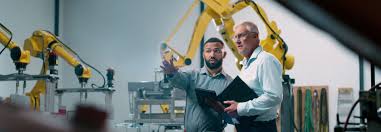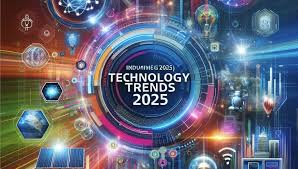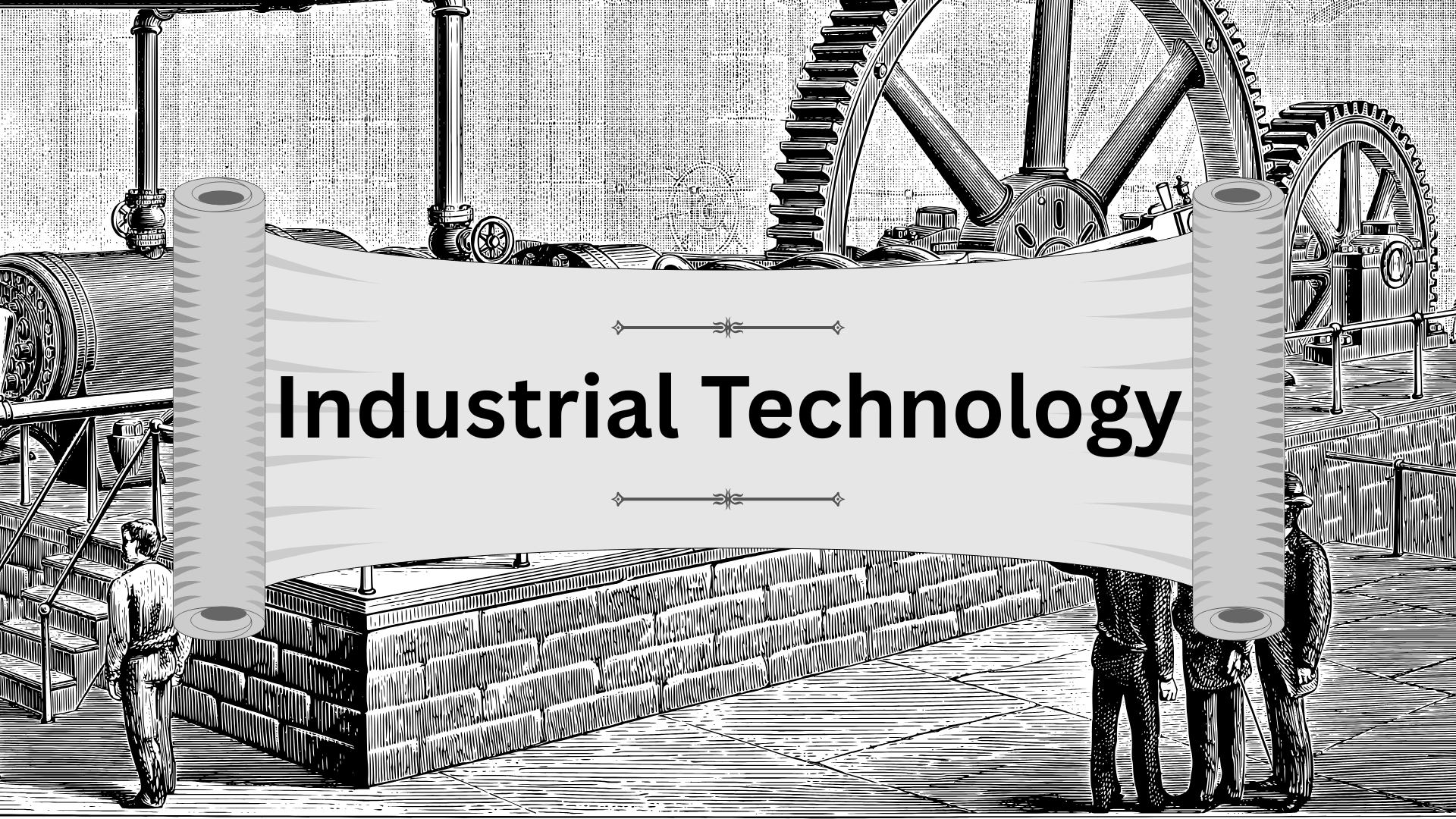Introduction
Imagine entering a factory where humans and robots work side by side, producing everything from sneakers to smartphones at breakneck speed, all without a single complaint about coffee breaks. Or visualize this: The industrial automation market, which powers the foundation of our daily lives, is expected to reach a staggering $169.82 billion globally in 2025. IT is the unsung hero that transforms ideas into tangible goods more quickly, intelligently, and environmentally than ever before.
However, what is industrial technology exactly? Though that’s part of the allure, it’s not just about huge machines clanking away in smoky warehouses. Efficiency, safety, and sustainability in production are achieved through the astute combination of engineering, manufacturing innovation, and digital wizardry.
Everything we use is impacted by IT, from the electric vehicle charging station in your garage to the automation systems in auto factories and IoT sensors tracking supply chains.
IT isn’t just for seasoned engineers in hard hats in a world where speed and sustainability are paramount; it’s also for young professionals pursuing high-tech careers, curious kids dreaming of robot friends, and even retirees experimenting with 3D printers. Did you know that this year, the value of the industrial machinery manufacturing sector alone is expected to reach $947.37 billion? That’s more economic power than many nations display!
Who says tech talk can’t be entertaining? In this captivating dive, we’ll examine IT with a conversational twist and a dash of humor. We’ll go over its background, significance, popular professions, upcoming trends, and how anyone, regardless of age, can get involved. Consider it your helpful guide to the mechanisms that drive our contemporary world. Are you prepared to accelerate? Now let’s equip ourselves with industrial technology!
What Is Industrial Technology?
IT isn’t some abstract concept locked in textbooks. It’s the practical powerhouse that turns raw materials into finished products we rely on daily. From food processing to aerospace, it encompasses tools, systems, and methods that boost efficiency while cutting waste. And with the rise of Industry 4.0, it’s evolving into a digital dynamo, blending physical machinery with data analytics for super-smart operations. Let’s face it, though: IT isn’t just a theoretical idea found in textbooks. It is the useful engine that transforms raw materials into the final goods we use on a daily basis.
It includes equipment, processes, and systems that increase productivity while reducing waste in everything from food processing to aerospace. And as Industry 4.0 takes off, it’s turning into a digital powerhouse that combines data analytics and physical machinery to create incredibly intelligent operations. Like the Swiss Army knife of manufacturing, industrial technology is adaptable, necessary, and always ready to tackle a challenge. Fundamentally, it is the use of technology and engineering to streamline production procedures, resulting in better, faster, and more affordable products. Industrial technology makes sure that industries run smoothly by integrating smart sensors and optimizing assembly lines.
Consider your favorite device; it’s likely that industrial technology was a major factor in its development. It’s what enables factories to manufacture millions of units without the onset of human error or boredom. Industrial technology essentially creates a symphony of productivity by bridging the gap between human ingenuity and machine precision.
Core Components of IT
Diving deeper, industrial technology breaks down into several key pillars that keep the wheels turning. Here’s a quick breakdown:
- Hardware and Machinery: The physical backbone, like robotic arms and conveyor belts. Without these, industrial technology would be all plans and no punch.
- Software and Automation Systems: The brains—think control software that directs robots or AI algorithms optimizing workflows. This is where manufacturing innovation shines.
- Networks and IoT: Connecting everything via sensors and data streams. Industrial technology relies on these for real-time monitoring, turning factories into smart ecosystems.
- Processes and Human Factors: Not just tech; it’s about organizational behavior, safety protocols, and ergonomics. After all, people are still the heart of industrial technology.
These components work in harmony, much like a well-oiled machine—pun intended. For more on basics, check our manufacturing essentials guide.
Examples in Action
Industrial technology can be found in unexpected places. Consider robotics in the workplace: precise welding of automobile frames by automated arms lowers mistakes and injuries. Or think about additive manufacturing with 3D printing, which reduces waste by layering materials to create custom parts as needed.
Sensors are used by industrial technology in food production to keep an eye on temperature, guaranteeing that your snacks remain fresh. It even underpins prosthetic precision tools in the medical field. By making the impossible commonplace, these examples demonstrate how industrial technology is not only effective but also transformative.

Evolution of Industrial Technology
It wasn’t like a robot from a science fiction movie when industrial technology first appeared. Beginning with steam-powered clunkers and ending with today’s AI-driven wonders, its story is a thrilling tale of innovation. Who knew coal could spark a revolution? Let’s turn the clock back a bit and give a humorous acknowledgement of how far we’ve come.
Water and steam powered mechanized production during the First Industrial Revolution in the late 18th century. As industrial technology advanced from handcrafted crafts to mass production, factories sprung up like weeds. Fast forward to the 1870s, when Henry Ford and other pioneers used assembly lines and electricity to turbocharge things.
Automation and computers arrived in the middle of the 20th century, digitizing industrial technology. And now? Data reigns supreme in the age of smart factories. It’s thrilling, if a little dizzying, as if industrial technology had advanced from a bicycle to a supersonic jet.
Key Historical Milestones
To make sense of the timeline, here’s a table of pivotal moments in industrial technology:
| Year | Milestone | Impact on Industrial Technology |
|---|---|---|
| 1784 | Steam Engine Perfected | Powered early factories, kickstarting mechanization |
| 1870 | Electricity in Manufacturing | Enabled assembly lines and mass production |
| 1969 | First Industrial Robot | Introduced automation, reducing manual labor |
| 1979 | Flexible Manufacturing Systems | Allowed customizable production on demand |
| 2011 | Industry 4.0 Coined | Integrated IoT and AI for smart factories |
| 2025 | AI Boom in Industry | Predictive maintenance and efficiency surges |
This table highlights how industrial technology has accelerated, turning challenges into opportunities.
From Industry 1.0 to 4.0
From steam (1.0) to electricity (2.0), computers (4.0), and now cyber-physical systems (5.0), industrial technology has come a long way. Industry 4.0 combines IoT and big data in manufacturing to create networked factories that predict issues before they arise.
It’s funny, like your factory got a brain upgrade, and there won’t be any more “oops” moments. Sustainable manufacturing, where technology maximizes output while minimizing environmental impact, is emphasized by this change.
Why Industrial Technology Matters
By 2025, industrial technology will be the unseen engine powering everything from the food on your table to the clothes on your back. This explains why the products are eco-friendly, inventive, and reasonably priced. We would be forced to handcraft everything like artisanal hipsters in a pre-industrial slog without it.
But really, industrial technology is important because it addresses global issues like climate change, boosts economic growth, and generates jobs. The industrial software market is a titan that is changing industries, with a projected value of $146 billion in 2023 and $355 billion by 2030.
Boosting Manufacturing
By improving accuracy, decreasing downtime, and automating repetitive tasks, industrial technology boosts manufacturing. In the industrial sector, robotics manages hazardous tasks, and automation systems strengthen supply chains and increase production resilience.
For companies, this translates into increased productivity at reduced costs—imagine smart factories using sustainable technology to reduce energy consumption by 20–30%.
Visit our post on the fundamentals of automation.
Economic Impact Today
Globally, industrial technology contributes trillions to GDPs. It drives innovation in sectors like automotive and pharma, creating ripple effects in employment and trade. In the US alone, manufacturing powered by industrial technology supports millions of jobs.
Careers in Industrial Technology
Do you want a job that combines intelligence and strength? Think of starting salaries of $80,000 or more for dynamic roles in industrial technology, which are expected to grow by 10-15% by 2030. It is available to people of all ages, from entry-level technicians to executives.
Careers in industrial technology combine cutting-edge technology with hands-on work, whether you’re a midlifer changing gears or a teenager coding robots. Some positions also allow you to supervise factories from the comfort of your own home, even in your pajamas, thanks to remote monitoring tools.
Top Job Roles
Here’s a bulleted list of hot careers in industrial technology:
- Manufacturing Engineer: Designs processes; salary ~$95,000. Solves production puzzles.
- Automation Technician: Maintains robots; the go-to fixer for tech glitches.
- Industrial Technologist: Oversees operations; blends engineering with management.
- Data Analyst in Industry: Crunches numbers for efficiency; big data guru.
- Sustainability Specialist: Focuses on green tech; saves the planet one factory at a time.
- Robotics Programmer: Codes machines; like playing with giant Legos.
- Supply Chain Manager: Optimizes logistics; keeps the world moving.
Explore our career paths in tech guide.
Essential Skills Needed
To thrive, master these skills in industrial technology:
- Technical know-how: Programming, CAD, and IoT basics.
- Problem-solving: Fixing breakdowns under pressure.
- Soft skills: Communication for team collab.
- Adaptability: Keeping up with trends like AI.
Certifications in areas like robotics boost your edge.
Future Trends in Industrial Technology
Peeking into 2025 and beyond, industrial technology is set for explosive growth. With AI weaving into everything, expect factories that think for themselves. The tech trends outlook points to agentic AI and spatial computing as game-changers.
Humor: Soon, your assembly line might unionize—kidding, but AI could handle negotiations! Trends focus on sustainability, with biotech and redesigning industrial processes leading the charge.
AI and Automation Rise
AI is revolutionizing industrial technology, predicting maintenance and optimizing energy. By 2025, generative AI dominates, reshaping manufacturing. Automation trends include collaborative robots (cobots) working safely with humans.
Sustainable Tech Innovations
Sustainable manufacturing is huge, with trends like lightweight materials and 3D printing reducing waste. Industrial technology aims for net-zero, using nano-formulations and advanced composites.
IoT in Smart Factories
IoT connects devices for real-time data, creating smart factories. This boosts efficiency, with the IIoT market booming due to predictive analytics.
Internal: Our IoT guide.

Challenges in Industrial Technology
Industrial technology isn’t without hurdles—like a robot with a glitchy circuit. Rapid changes bring skills gaps and security risks, but they’re opportunities in disguise.
E-waste and digital divides persist, but solutions like upskilling programs are emerging.
Skills Gap Issues
With tech evolving fast, there’s a shortage of skilled workers. Industrial technology needs more training in AI and data analytics to bridge this.
Cybersecurity Threats
As factories go digital, cyber-attacks rise. Industrial technology must prioritize secure systems to protect data and operations.
Read more: 9 Breakthrough Technologies That Will Change the World in …
How to Dive into Industrial Technology
Excited to join the industrial technology revolution? It’s easier than assembling IKEA furniture—start small, build skills, and network.
No age limit: Kids can tinker with kits, adults pursue certs.
Education Paths
Degrees in industrial technology or engineering are gold. Online programs cover manufacturing innovation and automation. Community colleges offer hands-on training.
Link: Industrial tech programs.
Beginner Resources
- Free courses on Coursera (e.g., Industry 4.0).
- Books like “The Fourth Industrial Revolution.”
- Communities like Reddit’s industrial engineering forums.
Read more: 10 Key Breakthrough Technologies of 2025
Conclusion
In summary, we have witnessed the evolution of industrial technology from steam fantasies to AI realities, enabling innovations, economies, and manufacturing. With opportunities in robotics, IoT, and other fields, it is the driving force behind our world’s efficiency, sustainability, and excitement, affecting people of all ages.
However, obstacles like skills gaps serve as a reminder to adjust. Industrial technology is about people creating a better future, not just about technology. It’s essential to life, whether you’re creating smart factories or simply enjoying your technology.
Post your opinions in the comments section! How can we address sustainability, or what do you think about AI in industry? Let’s ignite some industrial inspiration by sharing below!
Read more: Information Technology: The Shocking Guide 2025
FAQs
What is industrial technology?
Industrial technology involves engineering and manufacturing methods to improve production efficiency, safety, and profitability. It includes automation, robotics, and IoT for processes like assembly and data analysis. Essential in sectors like automotive and food, it drives innovation and sustainability for modern economies.
What are examples of industrial technology?
Examples include robotic arms for welding, 3D printing for custom parts, and IoT sensors for monitoring equipment. Others are CNC machines, conveyor systems, and AI-driven quality control. These tools enhance manufacturing innovation, reducing waste and boosting output across industries.
Why is industrial technology important?
Industrial technology boosts productivity, cuts costs, and promotes sustainability in manufacturing. It creates jobs, supports economic growth, and enables mass production of goods. With trends like Industry 4.0, it addresses global challenges like resource scarcity and environmental impact.
What careers are in industrial technology?
Careers include manufacturing engineers, automation technicians, and data analysts. Roles focus on designing processes, maintaining systems, and optimizing operations. Skills in programming and problem-solving are key, with high demand and salaries often exceeding $80,000.
What are future trends in industrial technology?
Trends for 2025 include AI integration, sustainable materials, and IoT in smart factories. Automation and biotech will redefine efficiency, while cybersecurity grows vital. Expect growth in robotics and data analytics, transforming manufacturing into adaptive, eco-friendly systems.

